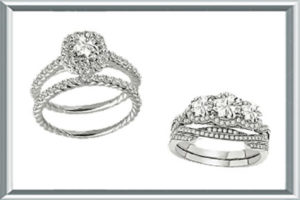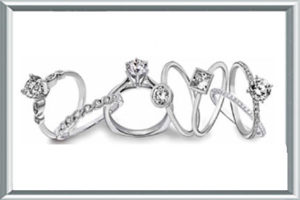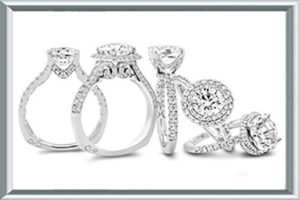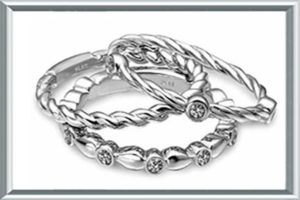Going Platinum
 The U.S. economy is not only exhibiting growth, unemployment remains at a historic low. Coupled with the current metal prices, the outlook for the jewelry industry in the U.S. remains strong and platinum continues to outperform the market, reports the Platinum Guild International (PGI). With platinum jewelry sales growing at +12% in the third quarter, it makes the outlook of 2017 very positive.
The U.S. economy is not only exhibiting growth, unemployment remains at a historic low. Coupled with the current metal prices, the outlook for the jewelry industry in the U.S. remains strong and platinum continues to outperform the market, reports the Platinum Guild International (PGI). With platinum jewelry sales growing at +12% in the third quarter, it makes the outlook of 2017 very positive.
With the combination of advantageous pricing and trade/consumer communications in the fourth quarter, PGI anticipates platinum jewelry sales will outperform the 2017 estimate of +5% to +7%. Overall, the economic climate in the U.S. is upbeat, benefiting jewelry as a category.
A favorite on the red carpet, platinum has always been aspirational, says Phyllis Bergman, designer for Mercury Ring a division of Interjewel in New York. “You never hear someone say look at my gold ring, but you do hear people qualify their jewelry when it’s platinum. Platinum is considered the finest metal there is. Unlike gold, it’s naturally white and never needs to be plated. It will never fade or change color and there’s virtually no metal loss from daily wear. Platinum is the densest precious metal available, meaning it’s the safest metal to secure an important stone, and with current pricing, it has lessened the price disparity between platinum and gold.”
Setting the Scene
Since PGI started its “Platinum Crown” campaign last year, the category has seen double-digit gains in platinum  jewelry sales in the U.S., cites Kevin Reilly, PGI-U SA vice president. “The real opportunity for platinum, since it is the most secure setting for diamonds and all precious gemstones, is to introduce people to the metal by offering a platinum setting as an affordable option in a gold ring. The campaign gets platinum in the conversation.
jewelry sales in the U.S., cites Kevin Reilly, PGI-U SA vice president. “The real opportunity for platinum, since it is the most secure setting for diamonds and all precious gemstones, is to introduce people to the metal by offering a platinum setting as an affordable option in a gold ring. The campaign gets platinum in the conversation.
Reilly pitches to jewelers that it takes 33 minutes to increase an engagement ring sale by 4% to 6%: three minutes to communicate to a consumer the importance of setting a diamond and/or a precious stone in platinum; and 30 minutes for a bench jeweler to affix a platinum crown (head) to a gold ring. The retail price of a platinum crown as a separate component is about $350. Multiple that by the 107 engagement rings an independent jeweler sells on average in a year, resulting in an additional $37,000 without changing any stock.
“Jewelers can easily swap out the gold head in the majority of semi-mounts for platinum,” Reilly says, noting that PGI wants to make platinum prong sets on all engagement rings the industry standard. In addition to inspiring jewelers to promote platinum crowns, PGI intends to work with manufacturers to encourage them to set collections with platinum crowns.
 Angelique Crown, director of sales west region A.Jaffe, praises PGI’s program, for which the New York City manufacturer participates, having launched new collections of 18K gold rings with platinum heads. “We’re offering unique opportunities to our retailers and their customers to indulge in platinum. The difference in price between 18K gold and platinum makes platinum an everyday elegance.” She notes platinum crowns are an option in all of the brand’s collections, as A.Jaffe offers customization for most combinations.
Angelique Crown, director of sales west region A.Jaffe, praises PGI’s program, for which the New York City manufacturer participates, having launched new collections of 18K gold rings with platinum heads. “We’re offering unique opportunities to our retailers and their customers to indulge in platinum. The difference in price between 18K gold and platinum makes platinum an everyday elegance.” She notes platinum crowns are an option in all of the brand’s collections, as A.Jaffe offers customization for most combinations.
Bergman sees the platinum crown pitch also working for timeless, everyday stud earrings. “It’s a powerful message to have platinum involved as a component in the design. Platinum is a differentiating factor.”
While sales for platinum heads in gold rings are on the rise, Crown says the largest increase she notices is for engagement rings made solely in platinum.
Wearable & Marketable
Making platinum more attainable is a direction Bergman supports, especially for jewelry styles worn every day because of its durability. She cites platinum and diamond bands set with fancy shapes among its bestsellers.
because of its durability. She cites platinum and diamond bands set with fancy shapes among its bestsellers.
By exploring lighter weights and more negative space in platinum you can keep costs down for fashion styles, while still providing a durable metal that holds stones in place and allows them to sparkle, says Bergman.
Reilly concurs that much more can be done design-wise using platinum because of its unique attributes. He says designers worldwide are exploring new ways of working with platinum from 3D printing to diamond cut platinum beads on the chain and multi-functional lariats.
“We have felt for a long time that there is room in the marketplace for beautifully designed, well made, price-friendly platinum designs,” says Reilly, “especially in delicate styles that lend themselves to layering.”
Leave a Reply
You must be logged in to post a comment.